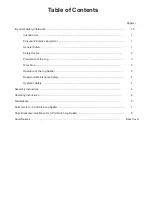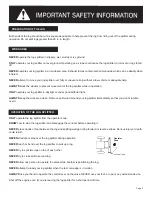
NOTE: This log splitter was partially assembled at the factory. Refer to the drawing and parts list should it become necessary to
disassemble the unit for repair or replacement of parts.
STEP 1: Remove all the components from the crate. Inspect each piece for shipping damage. If any part is damaged, contact your dealer or
delivering carrier.
STEP 2: Attach the four legs to the A-frame stand (18) using the 5/16 in. NC x 1-1/2 in. hex cap screws (28), 5/16 in. lockwashers (29)
and the 5/16 in. hex nuts (30). Tighten.
STEP 3: Insert the draw pins (19) into the lower holes on the A-frame stand (18). Secure with 7/8 in. lockwashers (20) and 7/8 in. hex
nuts (21). Tighten.
STEP 4: Stand the beam (1) on end. Check to see that it is stable. Line up the bracket holes on the A-frame stand (18) with the two ears
on the beam (1) and insert the pivot pin (16). Secure with clip pin (17).
STEP 5: Insert the stabilizer pin (23) through the hole on the A-frame stand (18) from underneath. Secure with 7/8 in. lockwasher (24) and 7/8 in.
hex nut (25).
STEP 6: Carefully lower the beam to the horizontal position. Be certain that the ground stand is securely in place. Put the lynch pin
through the hole in the stabilizer pin (23) to hold the beam in place.
STEP 7
: Attach the hydraulic fittings (13) provided in the hardware kit to the valve (14).
STEP 8: Back the tractor into position and slide the lift arms over the draw pins on the A-frame/stand (18). Secure with lynch pins
(not provided). Attach the top link from the tractor to the clevis on the A-frame/stand (18) and secure with a top link pin and
a lynch pin (not provided).
STEP 9: IMPORTANT: The tractor must be able to handle Category I or Category II three-point hitch implements and be equipped with a
four-way valve (for double-acting cylinders) and hydraulic outlets.
The tractor owner’s manual should be consulted for instructions on tractor operation, safety and auxiliary hydraulic systems
pumping and return flow hookups.
Determine the easiest position to lock the tractor’s valve lever in the operating position. Then locate the pressure and return
ports with the valve locked in this position. Connect the hoses from the tractor to the log splitter with the flow from the pressure
port entering on the “IN” side of the valve. The return flow to the tractor should come from the “OUT” side.
After connecting the hoses to the valve, the system should be energized by moving the tractor auxiliary valve in the direction to
cause oil flow. Tie in place. Oil should flow in only one direction through the hydraulic valve. If the tractor auxiliary valve is
moved to the wrong position, the log splitter relief valve will not operate and damage to the tractor system or log splitter could result.
The tractor hydraulic system should be capable of delivering 6 to 25 gpm of oil at 1500 to 2500 psi for adequate splitting force
and speed. The tractor should have a cooling system to allow semi-continuous operation.
NOTE: Hoses to the tractor are
not
included. Specifications of the hoses and fittings supplied by the owner should be within
recommended ranges of the tractor operating pressure.
STEP 10:
Using the tractor three-point hitch, raise the log splitter to a convenient height and level with the top link. The log splitter may be operated
in either the horizontal or vertical position. See illustration on page 8.
STEP 11: A closed spool kit is included in the hardware/hydraulic kit for converting open center valves to closed center. Instructions are
included in the kit.
Page 5
ASSEMBLY INSTRUCTIONS

















